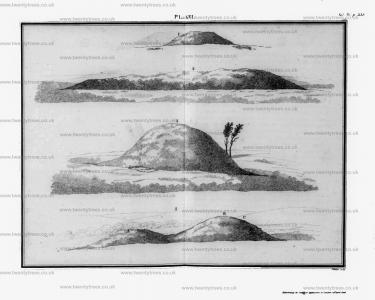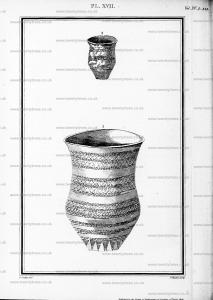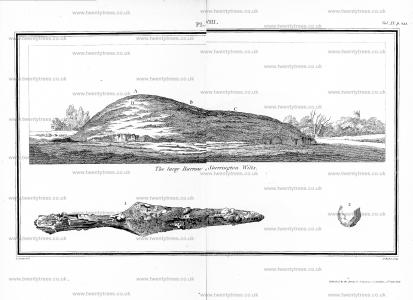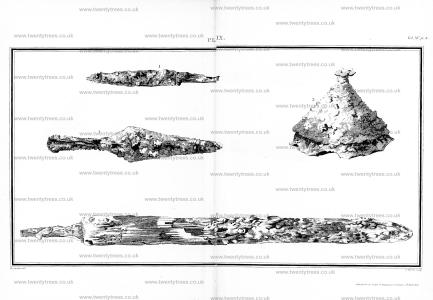Archaeologia Volume 15 Section XXXIII
Archaeologia Volume 15 Section XXXIII is in Archaeologia Volume 15.
Further Account of Tumuli opened in Wiltshire, in a Letter front Mr. William Cunnington (age 51), F.A.S. to Aylmer Bourke Lambert, Esq. F.R.S. F.A.S. and F.L.S. Communicated by Mr. Lambert. Read, Feb. 7, 1805.

Heytesbury, Sept. 14, 1804.
Sir,
As you were pleased to intruct me with the whole direction of opening the tumuli in your manors of Corton, Boyton, and Sherrington, this week, I shall give you the particulars of the discoveries as they occurred to me.
Archaeologia Volume 15 Plate XVI: 1. Boyton Barrow 2 [Map], 2. Boyton Down Long Barrow [Map], 3. Boyton Barrow 1 [Map], Corton Long Barrow [Map] South View,

Corton Long Barrow [Map][a] is situated about a mile and a quarter fouth of the river Wilye, in the Tenanty field, on a hill called Barrow Hill, from the tumulus we opened. Its situation commands home pleasant, (though not extensive,) views over a great many of the villages on the banks of the Wilye.
It stands exactly east and west, having its broad end to the east; the plough has made encroachments both on the sides, and on the east end;, at this time, the extreme length is 216 feet, by 2$ feet at the east end, and its highest elevation above the adjoining ground, 9 feet. Until this week, I conceived this tumulus to have been a double barrow, and the finding a rude urn, containing, burnt human bones, on the west end marked A, strengthened this opinion. [a] However, the discoveries made in the east end, prove it to have been originally a regular long barrow, similar to several I have opened on the Wiltshire Downs; therefore, the parting in the middle must have been occasioned by the farmers having taken away the earth for agricultural or other purposes. By much the greater part of our long barrows stand nearly east and west, as this does, having the east end much wider than the other, and at this end, we generally find some skeletons. We began the second opening of this barrow, by a large section at B: but making no discoveries there, I was led to consider it as a long barrow, and therefore made another section at C; when, after clearing out the earth, &c. to the depth of about two feet, we came to a large stone which required three men to lift it out. This proved to be the top of a pyramid of loose flints, marl stones, &c. which widened as we approached, the bottom, where the base of the ridge measured more than 20 feet in length, by about, 10 feet in width. Beneath this ridge of flints, &c. we found eight skeletons lying in several directions, as though they had been thrown on a heap without any ceremony.
Seven of them were adults, though of different ages, but the eighth was the skeleton of a child not more than seven or eight years of age. These eight skeletons lay on the floor of the barrow, between two excavations in the native soil, of an oval form, seven feet apart. These oval pits, or cists, were about 4 feet long, by about 2½ deep; they were neatly cut into the chalk, and were, with the skeletons, covered with the pyramid of flints and stones.
Note a. See Plate XVI. Fig. 4, which exhibits a south view.
Note b. You will probably recollect that I opened this part of the tumulus in 1801, when, immediately under the turf, I found the above-mentioned urn.

In these long barrows, we find a greater resemblance to each other, than in the circular: but from finding no urns, arms, nor trinkets of any kind, we are more at a loss for a clue to their history, than we are to the latter. In one long barrow, I found burning had been practised, and at the end, near the interment, the heads of some oxen: part of one of the latter had been burnt. In another, where a great number of skeletons were found, we discovered the heads and slough of the horns of several oxen: these were lying at the east end, near the skeletons.
The next barrow [Boyton Barrow 1 [Map]] opened, was the large circular one standing on the edge of Boyton Downs, and about 70 yards north of the great long barrow [Boyton Down Long Barrow [Map]] [d] on Sherrington manor, the boundary line running near the latter barrow.
This circular tumulus is 76 feet in the base diameter, and elevated 14 feet above the plain; being situated on high ground, it commands extensive views to the north and east. See Plate XVI. fig. 3. To open this barrow, we made a large section from north to south: in the first stratum, about two feet thick, composed chiefly of vegetable earth, we discovered nine skeletons lying in different directions. [e] Some years ago, your grandfather ordered some trees to be planted on this barrow, when the men employed in this work discovered four skeletons, which were afterwards interred in Boyton church-yard; therefore the whole number of bodies discovered on the top of this tumulus were thirteen. After we had worked through this stratum of vegetable mould, we came to another of small loose flints, similar to what are now picked off the arable land in this neighbourhood, for mending the roads; the latter was more than four feet thick. We next came to a stratum of black vegetable earth, which continued till we came to the bottom, at the depth of eight feet more, (viz. fourteen feet from the surface): here, and nearly in the centre of the barrow, in a shallow ciff, in the original soil, lay the burnt bones of the Briton for whom the tumulus was erected: they were piled in a small heap, but without any arms, urn, or trinkets. It is rather extraordinary, that notwithstanding the long space of time these bones must have lain in the damp earth, yet they were to all appearance as white, and handled as dry, as though recently interred, [f].
Note d. Plate XVI. Fig. 2.
Note e. Part of these skeletons lay with their heads to the north, and others to the south, but apparently in no regular order.
Note f. I do not mention this circumstance as peculiar to this barrow, as it is very frequent.

The skeletons found on the top of this, as in many other barrows, I have confidered as recent interments, or they may have been the slaves or dependants of the great personage below, or captives taken in war. I am more inclined to the latter opinion, from the careless manner in which these bodies were interred, as we sometimes find them thrown one over the other, in every direction.
The earth [g] composing the lower stratum of this barrow, is like rich garden mould, and is generally intermixed more or less with animal bones, rude pottery, and, if cremation has been practised, charred wood and ashes. On opening a tumulus of this description, the question naturally occurs, from whence is the earth, so different to the surrounding soil, brought? I am aware that in the space of two thousand, or fifteen hundred years, the soil might have undergone some changes; also, that on some parts of our downs, we now find black mould: yet, from the animal bones and pottery intermixed, (of which we find an abundance,) I am of opinion, that at the period the tumulus was raised, the Britons resided near the spot: of course, the earth, from habitation, would be like the earth in our villages in the present day; I am more inclined to this opinion, from having found the same kind of earth in the numerous towns or habitations of the Britons, now to be found on the Wiltshire Downs. I cannot conceive that the fires and victims slain when performing the funeral rites, with the bones of the victims, would produce those appearances, because we do not find enough of the large bones, excepting in a few instances: but we find the teeth of almost every animal: indeed, every thing has the appearance of that kind of earth we find in our village gardens.
Note g. I add these remarks, in consequence of the conversation between yourself and Mr. Wyndham, on the subject of the black earth, although the earth in this barrow has little affinity to the stratum of black, sooty earth, found under most of our long barrows.
The third, a circular tumulus [Boyton Barrow 2 [Map]], see Plate XVI fig. I. in Boyton manor, is situated on a neck of land, projecting from the great ridge wood, to Stockton sheep pond, having Dean Valley on the right. This barrow is 40 feet in diameter, and 3 feet nine inches in elevation; at the depth of four feet in the native chalk, (7 feet 9 inches from the top of the barrow,) we found the skeleton of a young person [h] lying with the head nearly east, this circumstance is unusual in what I have supposed primary interments, viz. where skeletons are interred at a great depth in a barrow; in such cases the head generally lies to the north, or nearly so. [i] The bones were in very good prefervation, and the teeth, (a most beautiful set,) were perfectly white. Near the feet of this skeleton, lay the fragments of a very handsome drinking cup; [k] about a foot from this, we found another very small cup, both of which I have since repaired by a cement, which has enabled Mr. Crocker to make good drawings of both.
The large cup, [l] or vase, holds nearly two quarts: it is of a brick colour, and on first sight might be mistaken for the Roman Samian pottery, but, on a nearer view, you perceive (notwithstanding the neat appearance,) that it is very imperfectly burnt, and that the ornaments are done by the hand, without a lathe; it stands 9 inches high, and measures 6 inches over the brim, see Plate XVII. Fig. 1. The small black cup is, in size and form, like some modern cream pots; it is 3¼ inches high; see Fig. 2.
Note h. I suppose from 20 to thirty years of age.
Note i. On top of barrows, we find the fkeletons in every direction.
Note k. The wide brim and large size rather militate against appropriating those vessels to this purpose.
Note l. This is the largest drinking cup I ever saw.


The apparent want of system in the British Sepulchres, gives us much trouble in examining them: this we experienced in a great degree, when opening the large Sherrington barrow [Map], see Plate XVIII.
This tumulus is situated on the borders of Sherrington field, about a hundred yards south of the river Wilye, and not more than a furlong south of the village of Codford. If you conceive an egg cut in two, lengthwise, and one half placed on the ground with the convex side upwards, the great end to the WNW you have the shape and position of the barrow. It is 108 feet long, and 80 feet wide in the broadest part, [m], and at A, 14 feet in elevation; it is chiefly raised by gravel near the Wilye. We opened this tumulus by a large section at the large end, and on the highest part: when at the depth of about 16 inches, we found 4 skeletons, lying from south to north; at the depth of 14 feet, we came to the floor of the barrow, [n] which was covered with charred wood and ashes; on the fouth fide of the floor, was a neat circular cist, made in the original soil, about two feet in diameter, and about sixteen inches deep; in this cist, we found the head of an ox, and one small horn of a deer. In this cist, or near it, we expected to have found the primary interment; being disappointed, we made two large sections at B and C. In the first, at the depth of eighteen inches, we discovered a skeleton lying from west to east; on the right side, we found an iron spear-head, see Plate XIX. Fig. 1. We pursued our researches to the floor of the barrow, but making no further discovery, we next sunk another pit, at C; here, at the depth of 18 inches, we discovered the skeleton of a stout man, [o] lying from west to east. On the right side of this skeleton, close by the thighs, lay a two-edged sword, the blade two feet in length, with rather an obtuse point, but no guarded hilt; it had been enclosed in a scabbard of wood, a considerable quantity of which, now adheres to it, (see Plate XIX. fig. 3.) On the right side of the head lay an iron spear, (see Plate XVIII. fig. 1;) and on the left, and close to the head, we found the umbo of a Shield, (see Plate XIX. fig. 3.) With the latter were found an iron buckle, a piece of leather, a strip of brass perforated in several places: all of which I conceive belonged to this Shield, as did also a thin bit of silver, see Plate XVIII. fig. 2; where it is drawn the full size. This probably covered the projecting part of the umbo; it is mutilated at both ends, and now appears like a small gorget. On the left side of the skeleton, and near the umbo, was found the knife, (see Plate XIX. fig. 4;) also several pieces of corroded iron. On the east of this skeleton, and in the same direction, we discovered two other skeletons, one of an adult, the other of a child four or five years of age; with these were found a small knife, and a piece of corroded lead: in the latter, was, (as I conjectured,) one or more iron rivets.
As this tumulus effentially differed from all the long barrows I have opened, it is necessary to make a few remarks. Of eleven long barrows which I have opened, nine have produced skeletons at the wide end, lying by a cist, or cists; the tenth, a large quantity of burnt human bones; and the eleventh, one skeleton interred near the centre of the barrow, three feet below the native soil. From these considerations, and many others, such as finding in different parts of the tumulus, a variety of the bones of quadrupeds [ p ] and birds, pieces of deers horns, also pieces of rude British pottery, I am of opinion this is a British tumulus, that the skeletons on the top were subsequent interments, and that, after all our labour, we have missed the primary interment.
Mr. Wyndham confiders it a Saxon barrow, and that the cist,. ox's head, &c. were from sacrifices offered previous to, the interments: he may be right in this conjecture, yet the position, of the bodies militate against their being Pagan Saxons.
Note m. Viz. the base length and breadth.
Note n. The original soil, nearly on a level with the adjoining ground.
Note o. The extreme length of the thigh bone was nineteen inches.
Note p. In one place, we found deposited together the skeleton, or skeletons, of one or more quadrupeds, also of a large bird.

